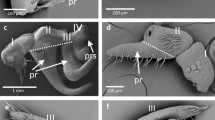Abstract
By behavioral and anatomical criteria, the pectinal sensory appendages of scorpions appear to be chemoreceptive organs specialized for detection of substances on substrates. These comb-like, midventral appendages contain tens of thousands of minute (<5 μm), truncated setae, called pegs, arranged in dense, two-dimensional arrays on the ventral surface. In this study we used extracellular recording techniques to examine spontaneous and stimulated activity of sensory neurons within individual pegs. Chronic recordings lasting several days showed long-term fluctuations in spontaneous activity of sensory units in single peg sensilla, with peak activity coinciding with the animal's normal period of foraging. Several units were identified by the stereotypical waveforms of action potentials they elicit. Near-range olfactory stimulation of peg sensilla by volatile alcohols, aldehydes, ketones, esters, and carboxylic acids produced dose-dependent patterns of neural response. Contact stimulation with these chemicals, or water, or mechanical deflection of the peg tip also evoked activity in identifiable units. The peg sensilla appear to be broadly sensitive to odorants and tastants, suggesting they function similarly to the antennae of mandibulate arthropods.
Similar content being viewed by others

Author information
Authors and Affiliations
Additional information
Accepted: 12 April 1997
Rights and permissions
About this article
Cite this article
Gaffin, D., Brownell, P. Response properties of chemosensory peg sensilla on the pectines of scorpions. J Comp Physiol A 181, 291–300 (1997). https://doi.org/10.1007/s003590050115
Issue Date:
DOI: https://doi.org/10.1007/s003590050115



